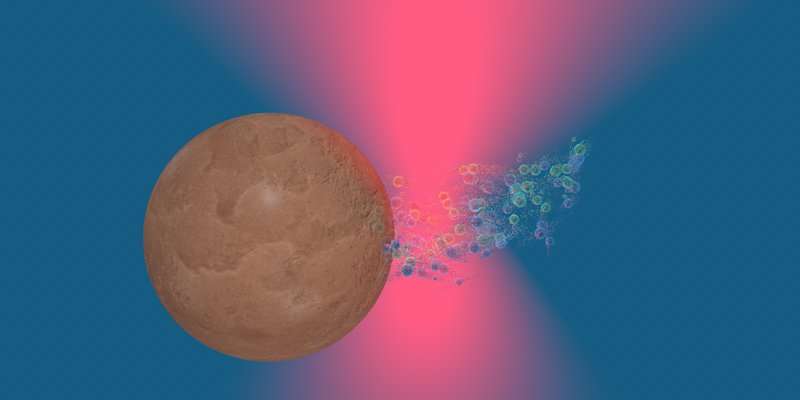February 12, 2018 report
Tiny engine powered by demixing fluid

An international team of researchers has developed a tiny, liquid-based engine powered by a demixing fluid. In their paper published in the journal Physical Review Letters, the group describes their little engine and possible uses for it.
The engine is essentially a tiny sphere orbiting a laser beam in a liquid solution. The sphere in the experiments was extremely tiny (2.48 micrometers in diameter) and made of iron oxide and silica. The liquid solution was a mixture of water and lutidine. The two ingredients were important, because together, they formed a critical liquid mixture that would separate at a desired temperature. In this case, separation occurred when its temperature warmed to approximately 34 degrees C.
Starting the tiny engine involved first placing the sphere into the liquid solution (held below its separating point) and then capturing it with optical tweezers—a laser beam. Initially, the sphere was held in place. The iron oxide allowed the sphere to absorb heat, which propelled the sphere away from the center of the optical tweezer beam. The power of the laser beam was then slowly raised, causing the temperature of the sphere to rise, which in turn caused a rise in temperature of the surrounding liquid. Eventually, as the temperature of the liquid reached its critical point, the two fluids became un-mixed, forcing the sphere to move slightly. But because it was still held in place by the tweezers, it moved in a partial arc. The sphere's temperature heated the liquid, further pushing the sphere when it reached its de-mixing point. This happened repeatedly, pushing the sphere all the way around the tweezer. It continued orbiting the tweezers for as long as laser power was applied.
The researchers note that the system had a small range of temperatures in which the sphere would smoothly orbit—applying to little laser power caused the sphere to stop, too much and the sphere's orbit would become erratic and at some point, it would break free of the tweezers grasp. The researchers suggest their engine could be used as a tiny mixer.
More information: Falko Schmidt et al. Microscopic Engine Powered by Critical Demixing, Physical Review Letters (2018). DOI: 10.1103/PhysRevLett.120.068004
ABSTRACT
We experimentally demonstrate a microscopic engine powered by the local reversible demixing of a critical mixture. We show that, when an absorbing microsphere is optically trapped by a focused laser beam in a subcritical mixture, it is set into rotation around the optical axis of the beam because of the emergence of diffusiophoretic propulsion. This behavior can be controlled by adjusting the optical power, the temperature, and the criticality of the mixture.
Journal information: Physical Review Letters
© 2018 Phys.org


















